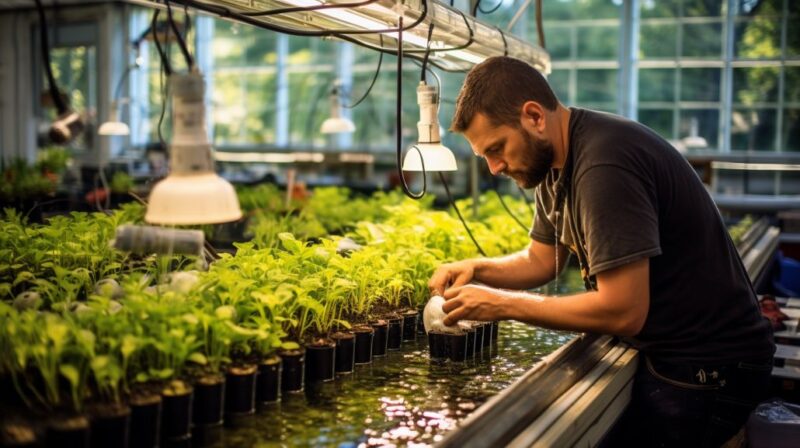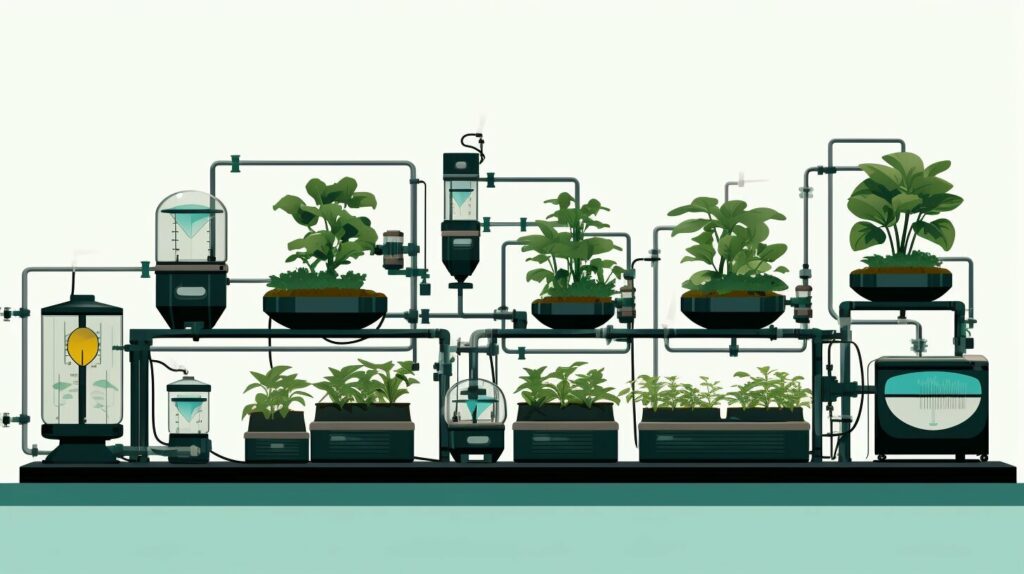This post may contain affiliate links and we may earn a small commission when you click on the links at no additional cost to you. As an Amazon Affiliate, we earn from qualifying purchases. You can read our full disclaimer here.
Aquaponics might be the perfect solution if you want to grow fresh produce and fish sustainably. This unique approach to farming merges aquaculture and hydroponics to establish a self-sufficient ecosystem that needs very few resources and generates impressive outputs. However, like any other farming method, aquaponics requires routine maintenance to ensure optimal performance and long-term sustainability.
Understanding the Basics of Aquaponics is crucial before you start your own system. In brief, aquaponics is a closed-loop system that uses fish waste to fertilize plants, purifying the fish’s water. The result is a mutually beneficial relationship that allows you to grow fish and plants in a compact space. But to keep your aquaponics system running smoothly, you must establish a routine maintenance schedule that includes daily, weekly, and monthly tasks.
Key Takeaways
- Aquaponics is a cutting-edge farming technique that blends aquaculture and hydroponics.
- Routine maintenance is crucial for your aquaponics system’s optimal performance and long-term sustainability.
- Daily, weekly, and monthly tasks should be included in your aquaponics routine to keep your system running smoothly.
Related Posts:

Understanding the Basics of Aquaponics
Aquaponics is an eco-friendly farming technique that merges aquaculture and hydroponics. It entails cultivating plants and fish in a self-sustaining system where the waste from fish is utilized as fertilizer for plants. In return, the plants purify the water and create a healthy habitat for the fish to thrive.
To get started with aquaponics, you will need a few essential components. These include a fish tank, a grow bed, a pump, and piping to circulate the water between the two. The water in the fish tank is distributed to the grow bed and back using a pump. The piping system is designed to ensure a smooth and efficient water flow.
One of the most significant aspects of aquaponics is maintaining the proper water quality. The water must be kept at the right temperature and pH level for the fish and the plants to thrive. The ideal pH range for aquaponics is between 6.8 and 7.2, while the temperature should be between 68 and 86 degrees Fahrenheit.
Another crucial factor in aquaponics is the ratio of fish to plants. This ratio depends on the type of fish and plants you are growing, as well as the size of your system. Generally, a ratio of one pound of fish per ten gallons of water is a good starting point.
It’s also essential to monitor the ammonia levels in the water. Fish waste creates ammonia, which can be detrimental to the fish and plants if it accumulates. It’s recommended to regularly test the ammonia levels with a kit and make adjustments as necessary.
Growing fish and plants in a closed-loop system through aquaponics is an effective and eco-friendly method. By understanding the basics of aquaponics and maintaining the proper water quality, you can create a thriving ecosystem in your backyard.
Related Posts:
- Discover the Types of Aquaponics Systems: A Comprehensive Guide
- Best Fish for Aquaponics: Top Choices for a Thriving System
- Unlocking the Magic of Aquaponics: Discover the Synergy Between Aquaculture and Hydroponics
- Essential Guide to Pumps and Timers for Aquaponics
- Best Plants for Aquaponics: Top Choices for Thriving Systems
The Importance of Routine Maintenance
Maintaining your aquaponics system is crucial for its success. Regular maintenance helps keep the system functioning properly and ensures the health of your fish and plants. Here are some reasons why routine maintenance is important:
Waste Management
Fish generate waste that can accumulate in water and negatively affect their health. Routine maintenance helps remove excess waste from the system and prevents the accumulation of harmful materials.
Organic Matter
Organic matter, such as dead leaves and uneaten fish food, can also harm the fish and plants in your aquaponics system. It is important to clean regularly and remove organic matter to prevent the accumulation of harmful bacteria and other microorganisms.
Bacteria Levels
Bacteria are essential in the nitrogen cycle of an aquaponics system. However, it’s important to keep their levels in check, as an overabundance can negatively impact the health of your fish. Regular testing and maintaining bacteria levels can help prevent overgrowth and maintain a healthy balance.
Filter Maintenance
Filters are an essential component of your aquaponics system. Regular cleaning and maintenance of filters help ensure they function correctly and remove harmful materials from the water.
Nitrite and Nitrate Levels
Nitrite and nitrate levels can quickly become toxic to fish if not adequately managed. Regular testing and maintenance of these levels is essential for the health of your fish.
Cleaning Pumps and Aeration
Pumps and aeration systems are critical for maintaining oxygen levels in your aquaponics system. Regular cleaning and maintenance of these systems help ensure they function correctly and provide oxygen to your fish and plants.
Routine maintenance is essential for the success of your aquaponics system. By managing waste, organic matter, bacteria levels, filters, nitrite and nitrate levels, and cleaning pumps and aeration systems, you can ensure the health of your fish and plants and maintain a thriving system.
Daily Tasks for Aquaponics Care
Maintaining a healthy aquaponic system requires regular attention and care. Daily tasks are essential for ensuring the proper functioning of the system and the well-being of the fish and plants. Here are the daily tasks to keep your aquaponic system in top condition.

Monitoring Water Parameters
Monitoring the water parameters to keep an aquaponic system healthy is essential. You should check the water temperature, pH, and nitrogen levels daily. Use a thermometer to measure the water temperature and a pH test kit to measure the pH levels. Test the nitrogen levels using a nitrate test kit. Keep a record of the test results to track any changes in the water quality.
Observing Fish Health and Behavior
Observing fish health and behavior is an essential daily task. Check the fish for any signs of disease or stress, such as lethargy, loss of appetite, or abnormal swimming behavior. If you observe any problems, it is essential to take immediate action to solve them.
Checking Plant Growth and Appearance
Checking plant growth and appearance is another daily task that you should perform. Check the plants thoroughly for any indications of nutrient deficiencies, like leaves turning yellow or growth being hindered. Check the grow bed for debris or dead plant matter and remove it promptly.
Related Posts:
Weekly Tasks for Optimal Performance
To keep your aquaponics system running smoothly, you must perform weekly tasks to maintain the water quality, nutrient levels, and overall health of your plants and fish. Here are some crucial weekly lessons to keep your aquaponics system in top shape:
Performing Partial Water Changes
Performing partial water changes is an important weekly task to maintain water quality and prevent toxic buildup in your system. You should aim to change 10-20% of the water each week, depending on the size of your system. Use a test kit to monitor nitrates and other levels to determine the frequency and amount of water changes needed.
Adjusting Nutrient Levels
Ensuring the nutrient levels are adjusted every week is crucial to guarantee that plants receive the necessary nutrients to flourish. Use a test kit like API NITRATE 90-Test Freshwater and Saltwater Aquarium Water Test Kit to monitor nitrate levels and adjust the nutrient solution accordingly. Keep in mind that different vegetables and fish species have different nutrient requirements, so make sure to research and adjust accordingly.
Cleaning Filters and Removing Debris
Cleaning filters and removing debris is an important weekly task to maintain proper water flow and prevent clogs in your plumbing system. Check your filter and remove any debris that may have accumulated. You can also rinse your filter with water to remove any buildup.
Pruning and Maintaining Plants
Maintaining and pruning your plants is a weekly activity that can help them to grow stronger and healthier. Remove dead or dying leaves, and prune any overgrown plants to ensure proper air circulation and light penetration. Be sure to inspect for any indications of pests or illness and respond accordingly.
By performing these weekly tasks, you can ensure optimal performance and health of your aquaponics system. Remember that the pH level, air pumps, and water flow are factors to monitor and adjust. With a little effort and attention to detail, you can master your aquaponics routine and enjoy a bountiful harvest of fresh vegetables and fish.
Monthly Tasks for Long-Term Sustainability
To ensure that your aquaponics system remains sustainable in the long run, it’s important to perform monthly tasks that keep everything running smoothly. Here are a few tasks you should add to your monthly routine:
Comprehensive System Inspection
Performing a comprehensive system inspection once a month is crucial to maintaining the efficiency of your aquaponics system. During this inspection, you should check for leaks, cracks, or other damages that could compromise the system’s performance. You should also check the water levels, pH balance, and temperature to ensure everything is within the optimal range.
Evaluating Nutrient Levels and Adjustments
Checking the nutrient levels in your aquaponics system is another essential monthly task. You should evaluate the ammonia and nitrite levels to ensure they’re safe for your fish. To ensure your plants grow to their fullest potential, it’s important to test the nutrient levels in your water. This will help ensure they receive the necessary nutrients for optimal growth. Adjust your feeding and plant care routines to maintain the appropriate nutrient balance.
Assessing Overall System Efficiency
Finally, you should assess the overall efficiency of your aquaponics system every month. This includes evaluating the growth rate of your plants, your fish’s health, and your system’s overall appearance. If you notice any issues, take corrective action as soon as possible to prevent them from becoming bigger problems down the line.
By performing these monthly tasks, you’ll help ensure the long-term sustainability of your aquaponics system.
Related Posts:
- Unlocking the Potential of Aquaponics: A Sustainable Solution for Food Production
- The Future of Sustainable Farming: Exploring the Synergy of Aquaponics
- Harnessing the Power of Aquaponics: The Future of Sustainable Agriculture
Fine-Tuning Your Routine for Seasonal Changes
Aquaponics is a dynamic system that requires careful attention to detail to ensure optimal results. As the seasons change, your aquaponics routine must be adjusted to maintain a healthy and productive system. This section will explore how to fine-tune your routine for seasonal changes.
Adapting to Seasonal Variations
Your aquaponics system can be greatly affected by seasonal changes. As the temperature and daylight hours fluctuate, your plants and fish will have different needs. During the colder months, you will need to provide additional heat to keep your fish and plants healthy. During the hotter months, you must ensure your system is appropriately shaded to avoid overheating.
To adapt to seasonal variations, consider the following:
- Adjusting your feeding schedule to account for changes in fish metabolism
- Monitoring your dissolved oxygen levels more closely during the warmer months
- Adding additional aeration during the colder months to prevent oxygen depletion
- Increasing the frequency of water testing to ensure that your system is functioning optimally
Addressing Season-Specific Challenges
Each season presents unique challenges for aquaponics enthusiasts. During the summer, insects can become a significant problem, requiring additional measures to control their population. In the winter, nitrifying bacteria may need to be supplemented to maintain the proper balance in your system.
To address season-specific challenges, consider the following:
- Adding natural pest control measures, such as ladybugs or praying mantises, to your system during the summer months
- Using a clarifier to remove excess solids during the winter months
- Monitoring your ammonia levels more closely during the summer months to prevent fish stress
- Providing additional nutrients to your plants during the winter months to promote growth
You can ensure that your system remains healthy and productive throughout the year by fine-tuning your aquaponics routine for seasonal changes.
Related Posts:
- Unlocking the Power of Aquaponics: A Harmonious Fusion of Aquaculture and Hydroponics
- Discover the Magic of Aquaponics: A Sustainable Solution for Healthy Food
Troubleshooting Common Issues
Aquaponics systems are generally low-maintenance, but sometimes issues can arise. Here are some common problems you may encounter and how to address them.
Identifying Nutrient Imbalances
If your plants are not growing as well as they should, or if you notice yellowing leaves, it may be a sign of nutrient imbalances. Common nutrient deficiencies include:
- Nitrogen deficiency: This can cause stunted growth and yellowing leaves. Check your system’s nitrogen cycle and ensure that beneficial bacteria are present to convert ammonia to nitrites and nitrates.
- Iron deficiency: This can cause yellowing leaves with green veins. Iron is essential for chlorophyll production. Monitoring and adjusting your pH levels is necessary to ensure proper iron uptake.
- Calcium deficiency: This can cause distorted growth and tip burn. Check your water source for calcium levels, and consider adding a calcium supplement.
Addressing Fish Health Concerns
Fish are an integral part of your aquaponics system, and their health is crucial to the success of your system. Here are some common fish health issues and how to address them:
- Poor water quality: This can cause fish stress and disease. Test your water regularly for ammonia, nitrites, and nitrates, and ensure that your system’s nitrogen cycle is functioning correctly.
- Parasites: Fish can be susceptible to parasites such as ich and anchor worms. Quarantine new fish before adding them to your system, and treat infected fish promptly.
- Overcrowding: Too many fish in your system can lead to stress, disease, and poor water quality. Ensure that your system has adequate filtration and that you are not overstocking your tank.
Dealing with Plant-related Problems

Sometimes, despite your best efforts, plants may not thrive in your aquaponics system. Here are some common plant-related issues and how to address them:
- Root rot: This issue may arise if your grow beds are not draining efficiently or there is inadequate water circulation. Ensure that your grow beds have adequate drainage and that your water pumps function correctly.
- Pest infestations: Plants can be susceptible to aphids and spider mites. You might want to try natural pest control methods, like bringing in ladybugs or using neem oil.
- Nutrient deficiencies: As mentioned earlier, nutrient imbalances can cause plant growth issues. Ensure that your system’s nitrogen cycle functions properly and that your plants receive adequate nutrients.
To ensure a successful harvest and a smoothly running aquaponics system, it’s important to address and identify any common issues that may arise.
Conclusion
Congratulations! You have mastered your aquaponics routine and are on your way to becoming a successful aquaponics gardener. Following the daily, weekly, and monthly tasks outlined in this article ensures that your aquaponics system stays healthy and productive.
Remember, the key to a successful aquaponics system is balance. You must balance the needs of your fish, plants, and bacteria to create a thriving ecosystem. By monitoring your water quality, feeding your fish the right amount, and pruning your plants, you can maintain this delicate balance and reap the rewards of a bountiful harvest.
Remember to keep track of your progress. Take notes on what works and what doesn’t, and adjust your routine accordingly. With time and practice, you will become an expert aquaponics gardener and enjoy the benefits of fresh, organic produce and healthy, happy fish.
Thank you for reading this article. We hope that it has been informative and helpful in your aquaponics journey. Happy gardening!



